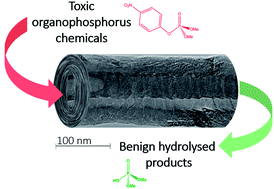Synthesis of hydroxylated group IV metal oxides inside hollow graphitised carbon nanofibers: nano-sponges and nanoreactors for enhanced decontamination of organophosphates†
Abstract
The confinement and enhanced catalytic properties of hydroxylated group IV metal oxide nanostructures inside hollow graphitised carbon nanofibers (GNF) has been demonstrated. GNF – a structural analogue of carbon nanotubes – were effectively filled with suitable precursor molecules of metal chlorides from the gas and liquid phases. Subsequent base-catalysed hydrolysis afforded amorphous, nanostructured hydroxylated metal oxide (MOx(OH)y where M = Zr, Ti, and Hf) thin films, which coat the internal surfaces of GNF. This versatile and general strategy allows the chemical composition and morphology of the encapsulated material to be modified by varying the conditions used for hydrolysis and post-synthesis thermal treatment. The increased Lewis acidic properties and high surface area of the zirconium composite promote the catalysed hydrolysis of dimethyl nitrophenyl phosphate (DMNP) – a toxic organophosphorus chemical. A four-fold enhancement in the rate of DMNP hydrolysis relative to its separate constituent components was observed, highlighting the surprising synergistic abilities of this composite material to perform both as a ‘nano-sponge’, absorbing the harmful compounds inside the GNF, and a nanoreactor, enhancing the local concentration of organophosphate around the hydroxylated metal oxide species, leading to improved catalytic performance.



 Please wait while we load your content...
Please wait while we load your content...